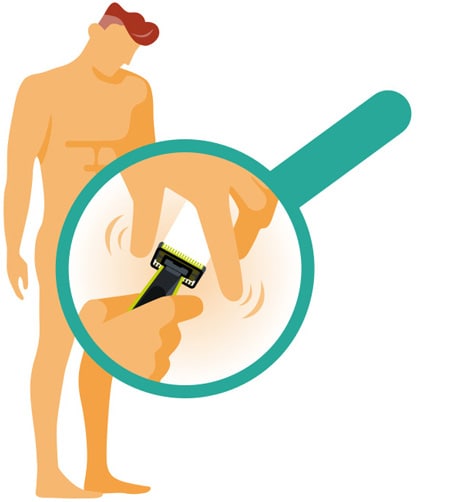Not everybody need or wants to manscape below the belt, but for those of us that do it can feel like there’s a lot at stake. After all, we’re talking about holding a blade against the most sensitive part the male anatomy. Manscaping isn’t a science and there are lots of differing opinions on how to do it, but rest assured that we wouldn’t advise our users to do anything that we wouldn’t do to ourselves. Consider this one voice of experience among many, bringing you a handy guide to shaving your balls.
Choosing the right tool
There are a lot of different razors, shavers and trimmers on the market, a lot of which aren’t going to be suitable for shaving your genitals. Keep in mind that the skin down there is soft and sensitive, and in the case of your balls it’s also likely to be wrinkled. When it comes to electric trimmers, the cutting teeth will cut anything that they come into contact with. For that reason, you should always, always opt for a trimmer that has a sensitive skin guard or comb to make sure that your supple skin stays a safe distance from the blades. The Philips Bodygroom series and OneBlade include skin guard features for this exact reason, helping you to shave close, but not too close. If you don’t have a suitable trimmer, a traditional razor will also do the job, but make sure the blade is new for best results to avoid the pulling that can occur with dull blades.
Prepare properly
If you’re particularly hairy down there, going straight in with a razor is likely to produce a tugging sensation that’s unpleasant even on less sensitive parts of your body. Use a trimmer with a comb or guard to shorten the hairs first. A small pair of scissors may also work if a suitable trimmer isn’t available, but take it slow and pull the hairs out to their full length before cutting, ensuring you keep a good distance between the blades and your skin. You might also consider trimming any hairs on the underside of your shaft, in the area where it meets your balls, because these hairs may look out of place when you’ve shaved the other areas. When the hairs are short enough for shaving, bathe the area with warm (but not hot) water to relax the skin and soften the hairs. Apply shaving foam or gel to ensure that the blade or trimmer will glide smoothly across your skin, and you’re ready to get started.
Take it slow
When it’s time to shave, starting from the top is the best way to go. Begin by lifting the shaft and use downward strokes of your razor or trimmer to remove hairs from the underside of the shaft (where it joins your balls) before moving on. When it comes to the main event, use the fingers of your free hand to gently spread the skin of the sack to create a flat, smooth surface to shave.

Starting at the top, make short, smooth downward movements with the shaver, capturing as many hairs as you can with each stroke to avoid going over the same area repeatedly. Aim for strokes that are long enough to avoid skin irritation from over-shaving, but short enough to ensure that any mishap are minor Continue the process until your balls are fully smooth on all sides, including the very bottom, using the fingers of your free hand to spread the skin and applying more foam or gel as you go.
After care
When you’re happy with the results, rinse the shaved areas with warm (but not hot) water to remove any excess foam or gel, then apply some mild aftershave balm or moisturiser to reduce redness or irritation. Depending on your goal and hair growth, repeat the same process as often as necessary.
-
![Pubic hair, having less looks like you have more]()
Pubic hair, having less looks like you have more
Read the article -
![Welcome to you: a beginners guide to your skin]()
Welcome to you: a beginners guide to your skin
Read the article -
![How to manscape downstairs]()
How to manscape downstairs
Read the article





